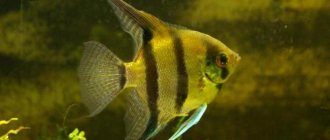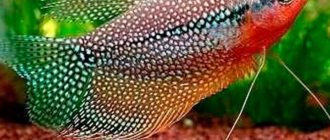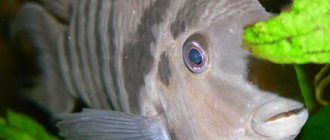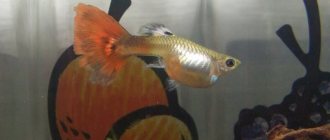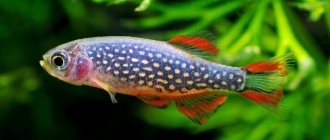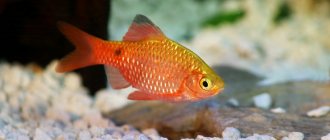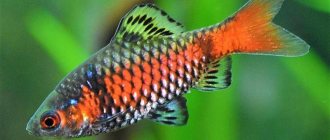Cichlids
Simplicity of content:
Latin name: Herichthys cyanoguttatus
Lifespan: 5-15 years
Maximum size: 20 cm.
Average cost: 400 rub.
In Latin this fish is called Herichthys cyanoguttatum. Cichlazoma diamond belongs to the family of cichlids (cichlids) and among them is one of the most popular for the aquarium. Its other names are also known - pearl cichlid and Texas cichlid.
Origin and habitats
The diamond cichlasoma Herichthys cyanoguttatus (formerly Cichlasoma cyanoguttatum) was described in 1854 by Spencer Baird and Girard. This species has three recognized subspecies, including the diamond cichlid (Herichthys c. cyanoguttatus), the green diamond cichlid (Herichthys c. carpintis) and Herichthys c. temporatum.
Green Diamond Cichlazoma
Until the mid-80s, more than 100 species of fish were classified in the genus Cichlasoma, but then it turned out that most fish did not fit into this genus and they were added to their own genera, or remained temporarily undefined and belonged to the genus “Cichlasoma.” in quotation marks until the scientific community decides where to classify them. There are only 12 species of true cichlases left. Nevertheless, the Texas cichlid among the Russian-speaking population is still best known as the diamond cichlid, although it is no longer a cichlid.
The Diamond Cichlid is a North American cichlid and has been found in rivers and lakes in Texas, USA, and northern Mexico. The Texas cichlid is the only cichlid native to the United States. Originally found in the Rio Grande River in Texas and south in northeastern Mexico, it was later distributed in central Florida and the Rio Verde River basin in Mexico.
Diamond cichlazoma is found in warm reservoirs, in large and small rivers. Usually hides among vegetation, where it digs through sand in search of edible food. It feeds on crustaceans, insects, worms and vegetation.
What does she do in her “free time”?
Cichlazoma diamond short-bodied is not constant in character. Sometimes she demonstrates her dignity and authority. Then her slow and smooth movements amaze with grace.
At other moments, she furiously and selflessly digs the soil in search of something interesting and, better yet, edible. In such cases, nothing is spared: neither valuable plant specimens, nor designer jewelry, nor bottom inhabitants. It should be noted that if a fish “declares war” on something or someone, the enemy will not be happy. She will rage and is unlikely to calm down until the item is destroyed or removed.
Description
Diamond cichlazoma has a very wide body (from the back to the abdomen), oval in shape, up to 30 cm in length.
The body is brown-gray in color with bright bluish scales, giving the fish a diamond-like appearance. Adult fish have two small black spots, one in the middle of the body, the second at the base of the caudal peduncle; Young fish have several spots between them. In adult males, the occipital hump appears on the head. Females are smaller than males.
Diamond cichlids can live up to 15 years in an aquarium, but the average lifespan is 10 years.
All cichlids and some saltwater fish such as wrasse and parrots have a common feature: a well-developed set of pharyngeal teeth located in the throat next to the regular teeth. They also have spiny rays in their dorsal, anal, pectoral and ventral fins to combat predators. At the front, these fins are soft, ideal for precise positioning in the water and do not interfere with fast swimming.
Diseases and prevention
Violation of the conditions of detention, non-compliance with recommendations regarding feeding, refusal of preliminary quarantine for newly acquired individuals, constant stressful situations can cause illness even in such a persistent species as Diamond Cichlazoma.
Let's look at the most common diseases.
Obesity
Reasons include:
- overfeeding (exceeding recommended portions or frequency of feeding);
- use of fatty meats;
- imbalance of the diet.
They should be eliminated immediately by switching the fish to proper nutrition, without ignoring fasting days.
Intestinal disorders
This disease is caused by poor quality feed. The choice of manufacturers, terms and conditions of food storage should be reconsidered.
Ascites
Dropsy. Reasons: insufficient filtration level or excessively low water temperature.
Signs:
- bulging eyes;
- bloating;
- ruffled scales;
- inactivity.
The sick individual is isolated. Antibiotics are used. The aquarium is disinfected.
Dermatoses caused by fungal infection
Description of the reasons includes: insufficient filtration or low level of substrate cleaning, violation of quarantine rules for new acquisitions.
Antifungal drugs are used.
Lymphocystosis
Reasons: violation of quarantine rules, presence of microcracks on the body of the fish.
It manifests itself in the form of the formation of many small nodules and warts of different shapes and colors. Possible bulging eyes and difficulty breathing.
During the treatment process, the water is replaced and its temperature is increased to +30 °C.
Hexamitosis
Hole disease. Caused by a single-celled flagellate parasite.
The causes of the disease include:
- use of low-quality feed;
- infrequent or excessive feeding;
- decreased immunity of fish;
- no quarantine for new pets.
Symptoms:
- white mucous discharge;
- blurred eyes;
- bloating;
- deep erosions of the skin;
- fin damage;
- enlargement of the anus;
- nutrition problems.
The sick individual is isolated. The temperature of its habitat increases. Antiprotozoal drugs are used: throughout the first week, every other day, 1 tablet of Metronidazole and 2 tablets of Furazolidone are added for every 20 liters, having previously performed a 4/5 water change. The fish are on a hunger strike. In the second week, the regimen is repeated, leaving only Metronidazole. Feeding is introduced: exclusively with fresh live food (tubifex, mosquito larvae).
Maintenance and care
The Diamond Cichlasoma is considered an easy to keep aquarium fish; it is omnivorous and will eat anything. Still, this fish is not for beginners - if you decide to get cichlids, you should not purchase this species first. The Texas Cichlid has a bad temperament and a belligerent attitude towards others, and is sure to make a mess in a beautifully decorated aquarium. Depending on how it is fed, it can become very polluting to the aquarium, and as a result, you will have to devote a lot of time to regular maintenance of your home pond.
To keep one aquarium diamond cichlid fish, it is recommended to use at least 190 liters of water, and to keep a pair – 380 liters. The aquarium must have a good strong current and effective filtration. This species prefers cooler water, with a temperature of 21 – 24 °C recommended.
Diamond cichlazomas are digging fish; they love to dig holes in the ground, so they need to be provided with a good layer of sand, 7.5 - 10 cm deep. Most live aquarium plants will not be able to coexist with these American cichlids - sooner or later the plants will be uprooted. In addition, Texas cichlids pick off and eat leaves.
Although most cichlids love caves and other shelters, it is better to provide diamond cichlids with a spacious aquarium for swimming with a minimum of decorations. If you want to create a natural environment (biotope) for your fish, then take a large, spacious aquarium, pour up to 10 cm of sand on the bottom, and use a small amount of round stones and driftwood as decorations, which will not interfere with the fish’s free swimming.
The aquarium lid must fit tightly and the lamps must be protected from possible damage.
The lighting in the aquarium depends only on your personal preferences; it can be either weak or strong.
Content Options
Temperature : 21 – 24 ° C; Breeding temperature : 22 ° C; pH : 6.5-8.0; Hardness : 8 - 15 dGH.
American Diamond Cichlids are considered "dirty" aquarium fish and therefore require strictly regular aquarium maintenance. Weekly changes of at least 25% of the water volume are required. First, the viewing glass of the aquarium is cleaned of algae using scrapers or a sponge, and then waste is removed from the bottom of the container using a siphon.
Habitat
Originally from the eastern regions of Mexico.
The natural habitat is limited to the Panuco River basin, which includes numerous lake systems in the lower reaches of the river. Brief information:
- Aquarium volume - from 200 liters.
- Temperature - 20–33°C
- pH value – 6.0–7.5
- Water hardness - soft or medium hard (5–14 dGH)
- Substrate type - sand or fine gravel
- Lighting - any
- Brackish water - no
- Water movement - weak to moderate
- The size of the fish is up to 20 cm.
- Food - any sinking food with herbal supplements
- Temperament - uncooperative with benthic species
- Keeping alone or in a mature male/female pair
Feed and feeding
Diamond cichlids are omnivores, eating all types of live, frozen, and dry food. These aquarium fish grow quite large, they need to be fed with high quality foods. When they grow up, Texas cichlids will eat both earthworms and small aquarium fish such as guppies with equal pleasure, and can attack larger fish. Worms, small fish, and shrimp are suitable as live food for adult fish. Additionally, you can give plant foods: lettuce, cucumbers, blanched zucchini.
Cichlids should not be fed mammalian meats such as red meat and ox heart. In the past, these products were considered the norm, but later it turned out that they lead to obesity in fish and, as a result, degeneration of internal organs.
Breeding/reproduction
The most difficult stage in breeding is finding a suitable mate. If the male and female are favorable to each other and are in a suitable habitat, then spawning will be a matter of time.
With the onset of the breeding season, the fish transform and the color becomes more intense. After a short but active courtship, the female lays several hundred eggs. The place for masonry is usually chosen to be a flat surface at the bottom, for example, a flat stone.
The incubation period lasts 2–3 days. In the first days of life, the hatched fry do not know how to swim and stay in one place, feeding on the remains of the yolk sac. At this time, the parents move the brood to another place - a small hole at the bottom. From the moment the eggs appear and for several weeks, adult fish fiercely protect their offspring.
Compatibility
North American Diamond Cichlids are a very aggressive and territorial species and are a very poor candidate for keeping in a community aquarium. Diamond cichlases are usually kept in large aquariums, with one fish or a couple of fish. However, the larger the volume of the aquarium, the greater the chance that cichlids will be able to get along with their neighbors.
Juvenile Texas cichlids are very passive, non-aggressive and even shy. Timid young fish may even suffer from lack of food if kept with other large or aggressive fish. But with age, diamond cichlids lose their passivity, become extremely aggressive and dangerous for any neighbors in the aquarium. Usually these fish become the most aggressive when they reach 13-15 cm in length. Some aquarists manage to keep this species with other large fish, but in most cases these fighters harass their neighbors to death.
Keeping an aquarium fish
The fish grows large, so a spacious aquarium is needed to keep it. So, to keep one individual you will need a container with a volume of 200 liters, and for a pair of fish 400 liters. If you keep cichlisoma in a smaller aquarium, it will not grow to its maximum size.
Fish litter while eating, dig in the ground, raising turbidity, so the filter in the aquarium must be powerful. Weekly you need to replace some of the water with fresh water. Use fine gravel or quartz sand as soil.
You can plant large, hard-leaved plants in your aquarium, such as Echinodorus or Anubias. Use driftwood, large rocks, and caves as shelter. Diamond cichlazoma spends most of its time near the bottom, but sometimes rises to the top. To prevent it from jumping out, cover the aquarium with a lid.
Mr. Tail recommends: species of cichlases
So far, the existing gradation in the aquarium industry makes it possible to classify cichlases into one family. There are many scientific classifications, but it is more interesting to simply describe the varieties that are most popular among lovers of home artificial reservoirs.
Very popular in modern aquarium hobby. These are small perch-like fish with bright colors and a rather calm character. They are capable of aggression during the period of spawning and caring for offspring, so it is still better to keep them in a cichlid with other representatives of their family. These can be parrots, pseudotropheus, barbs, gourami, swordtails, thornets.
It is considered a small fish, in nature its size is about 15 cm, in an artificial reservoir it is somewhat smaller.
The main color background is grayish-bluish, with wide, alternating white and black stripes on it, which really makes the fish look like a zebra.
Males are much larger than females, they are distinguished by the pointed shape of their anal and dorsal fins, and during the spawning period a bright red stripe is visible on their belly.
These cichlids really resemble a diamond due to the iridescent large scales and silvery spots evenly scattered throughout the body, even on the fins.
Body length reaches 15-17 cm, males are larger.
These fish are also quite peaceful for predators, although they are prone to fighting for territory.
Cichlazoma Severum
A very bright cichlasoma with a yellowish body, on which small orange specks are scattered, although in nature the color is completely different - grayish-greenish. But in aquariums only selected varieties are found, but they are also rare.
Sometimes it is called false discus because of its color. Whether these fish belong to the genus Cichlasom or Heros has not yet been fully determined.
In addition to the above-described “red pearl severum”, the decorative forms “blue emerald”, “red-headed”, “golden”, and many others are also in demand.
This variety of cichlases is highly aggressive, especially intraspecific. It is better to keep them separately in several pairs in a very large tank with proper zoning.
Cichlazoma Meeka
Another fairly popular species of aquarium cichlases comes from Guatemala and Southern Mexico.
The body length of the fish, painted silver on top, is 14-15 cm. Larger males have bright red spots on the belly and the lower part of the large head. The sharp fins are colored gold or have a purple tint.
Typically, these underwater inhabitants behave calmly in the aquarium, but defend their territory, so the tank should be divided into spacious zones.
Cichlasoma meeki in the wild is much larger in size, up to 35-40 cm. The fish is named after the American ichthyologist Meeki, who discovered this species of perciformes in 1933. Sometimes it is called mask because of the peculiar color of its head.
In the aquarium, Meeks usually behave slowly, but they completely transform during the mating season. At this time, it is better to house the couple separately. They love to rummage in the sandy bottom, picking out algae and turning over parts of the decorations.
They differ from other species of cichlids by a large knob-like growth above the upper part of the huge head.
A monogamous couple usually inhabits its own cave, where it breeds offspring. It is not recommended to keep more than three families in one, even a large aquarium.
The color of the scales is usually dark with a bluish, purple or almost black tint, but gray-silver individuals are also found.
We invite you to read: Everything about keeping sea turtles in an apartment
Cichlazoma Flamingo
These predatory fish are slightly smaller than their family members - from 8 to 14 cm in length. The name was given because of the unusual pinkish color, which can be very pale or more saturated. The most peaceful of all known species of cichlases.
Rainbow cichlazomas
One of the largest species of cichlids, even in an artificial reservoir some individuals reach 20 cm in length.
The coloring of the scales contains many bright colors - yellow, green, red, blue, which gave rise to the name of the variety.
The fish is very aggressive. Usually, one pair is selected from 6-8 individuals and moved into a separate tank. Even when zoning an aquarium, fights between males are inevitable.
Cichlazomas Bees
These perch-like fish are small in size (8-10 cm) and in nature are more often found in the Amazon River basin.
They have a very unusual and remarkable color. Each scale has a blue spot, which, when refracted in light rays, gives a unique play of colors - gold, black, azure.
The brightest color is found in yearlings. Juveniles are paler and calmer. And adult males do not get along with almost anyone; it is better for the pair to be kept in a separate aquarium.
Cichlazomas Labiatum
They are distinguished by their uniform yellowish-pink color and high intelligence. If a person approaches the tank, they follow him with their gaze and even beg for food. At the same time, their neighbors in an artificial reservoir are usually completely ignored.
The large head ends in a large, well-defined mouth, which is why Labiatum is often called the big-lipped cichlazoma.
Large underwater inhabitants (20-25 cm in length) with a large convex head and low lips.
The color is usually a mixture of three colors - a silver body, a bluish upper part and forehead, and a purple belly.
Sedzhik's cichlazomas
A small aquarium fish (10-11 cm), peaceful, even timid in nature, there must be caves and grottoes at the bottom for shelter.
The light brown, flat and round tall body is equipped with yellowish fins. Dark wide stripes cross the body.
This species has a pronounced habit of defending its territory, especially during the mating season. It is better to keep the pair in a small (about 50-100 l) own tank.
They are very different in their behavior from other cichlids. They can be called benign neighbors rather than dangerous territorial predators.
If the wine cichlid gets scared of something, it freezes and falls to the bottom, resembling a fallen leaf. This is facilitated by the peculiar coloring of the body (yellowish, pinkish, gray tones), it helps the fish to mimic.
They are considered excellent intercalary specimens due to their bright orange light coloring and forehead-shaped head.
They usually behave calmly in the aquarium, somewhat more aggressively only during the mating season and when the tank is overpopulated. Cichlasoma citrinellum are omnivores and do not refuse live, dry and plant food. They can even eat zucchini and watermelon.
Cichlazomas Menonuata
Shy and peaceful, they can even get along with angelfish. They can jump out of a pond out of fright.
The color of the body is dull, pale yellow; a black oblique stripe runs along the body from the pectoral fin in the middle of the dorsal fin.
Cichlazoma Salvini
Cichlasoma salvini originates from the central part of the American continent. The main background of the body is greenish or brownish-yellow with bright black stripes along the entire upper half and a red belly (in males).
The fish are quite peaceful, but can defend their territory; zoning of the aquarium is necessary. Body length is from 13 to 16 cm.
Cichlazoma Spilurum
The gray cichlasoma Cichlasoma spilurum has a large body, painted in a grayish-metallic color with pale transverse stripes and retracted dorsal and ventral fins.
Cuban cichlises
Cichlasoma tetracanthum or Tetracanthum in natural conditions lives in calm waters of Cuba and Barbados.
The main background of the body is grayish-silver. Strokes and spots of black color are scattered across it. The drawing, in spite of everything, is not repeated, it is unique.
Very dangerous and aggressive, suitable only for keeping as a pair in a species aquarium. Large ones - about 20-25 cm.
Cichlazomas Fascetum
Cichlasoma facetum or Chanchita comes from reservoirs in Brazil, Honduras, Uruguay, and Argentina. The colors are varied - grayish-yellow, bluish, green, red tones. The transverse stripes are pale and extend throughout the body.
Small, but very aggressive, this is a territorial species (protecting its living space).
Parachromis managuensis is a very powerful and beautiful fish with an unusual black and gold color and a unique shape of fins, which is why they received their second name - Jaguar. The body length of these underwater inhabitants of aquariums is large - up to 35-40 cm.
A tank of at least 500 liters is suitable, and preferably a large one, since the fish are aggressive and always make very sharp leaps when moving.
Eliot's Cichlazomas
They are somewhat reminiscent of Meeks in color and behavior, but the red spot on the belly is brighter.
This is an endemic species of African Lake Malawi. Large fish (25-30 cm) prefer bottom habitat and are able to live at depths of up to 25 m.
Because of their unique body coloring—large black spots on a lemon background—they are often called Golden Giraffes.
Unlike their brothers in the family, they are not monogamous, but prefer to live in a small harem, where there are three or four females per male. They should also be kept in a large species aquarium (at least 600 l). Two males will not get along together; one of them will definitely die in a fight.
Character
The Diamond Cichlid is one of the most aggressive cichlids. Fish defend their territory and also conquer it from others. The objects of attack are fish of other families, relatives and even crustaceans. Aggression increases during the breeding season. Not only the male, but also the female protects the nest. They show aggression towards all objects invading their territory.
The target of the attack can be the owner’s hand, objects behind the glass of the container that approach him. Cichlazoms can even jump out of the water to “get” the enemy. In order to reduce aggression, fish need space. When setting up an aquarium, you need to take into account the characteristics of the diamond cichlid.
Fish have quite developed intelligence. They recognize their owner. They can observe for a long time what is happening behind the walls of the aquarium. They are trainable - they can swim up to a signal and take food.
Diseases of diamond cichlase
Diamond cichlazomas have good immunity and resistance to diseases. Their few diseases are most often associated with improper care and maintenance errors.
Ascites
In old or untreated water, diamondback cichlazoma may develop dropsy or ascites. A sick fish becomes inactive, and you may notice bulging eyes. Fluid accumulates in the fish's abdomen, causing the fish's belly to swell and its scales to rise.
Treatment of fish should begin immediately when the first symptoms are detected. Individuals affected by the disease are placed in a separate aquarium and given baths with the addition of antibiotics (chloromycetin or tetracycline is used).
Ichthyophthiriasis
Diamond cichlazoma tolerates changes in the parameters of the aquatic environment very poorly. When the water temperature drops below optimal values, the fish may develop ichthyophthyriosis. The body of a sick individual is covered with whitish grains, similar to semolina.
At the first signs of disease, increase the water temperature in the aquarium and increase aeration. If the disease has reached an advanced stage, drug treatment is started.
According to general recommendations, each new fish should be kept in a separate aquarium for some time before being introduced into the general aquarium. This allows the newcomer to quickly adapt to the new environment, and the owner to observe the fish and treat it, if necessary.
How to distinguish a male and a female?
In order to determine the gender of an individual, it is enough to pay attention to the color of the body. The male is brighter, with contrasting shades and beautiful sparkling tints.
In addition, males are larger, they have a well-defined forehead, on which a tall fatty bump grows. Such a growth indicates a dominant position in the pack. It is worth paying attention to the dorsal and anal fins; in the male they are longer and sharper than in the female.
Sexual dimorphism in diamond cichlases is clearly visible. Males, as a rule, are larger than females, and they have a well-defined frontal tubercle. Before spawning, the male develops a vas deferens (like a pointed tube), and the female develops an ovipositor in the shape of a truncated pyramid.

